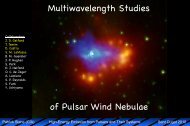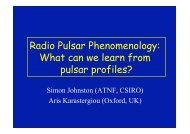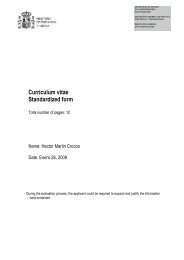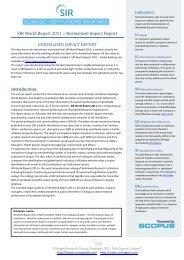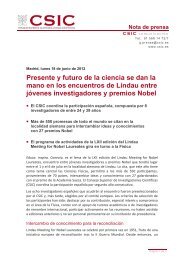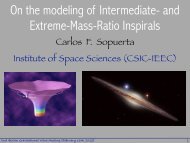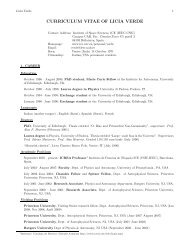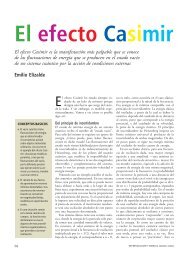Franck-Condon principle in excited Heavy Quarkonia - QWG2011 ...
Franck-Condon principle in excited Heavy Quarkonia - QWG2011 ...
Franck-Condon principle in excited Heavy Quarkonia - QWG2011 ...
- No tags were found...
You also want an ePaper? Increase the reach of your titles
YUMPU automatically turns print PDFs into web optimized ePapers that Google loves.
<strong>Franck</strong>-<strong>Condon</strong> Pr<strong>in</strong>ciple <strong>in</strong> Molecular PhysicsBottomonium Excited States and Υ(5S)<strong>Franck</strong>-<strong>Condon</strong> <strong>pr<strong>in</strong>ciple</strong> applied to open avor decaysConclusionsOutl<strong>in</strong>e1 <strong>Franck</strong>-<strong>Condon</strong> Pr<strong>in</strong>ciple <strong>in</strong> Molecular Physics2 Bottomonium Excited States and Υ(5S)3 <strong>Franck</strong>-<strong>Condon</strong> <strong>pr<strong>in</strong>ciple</strong> applied to open avor decays:Υ(5S) → BB(π)4 ConclusionsJuan M. Torres-R<strong>in</strong>con<strong>Franck</strong>-<strong>Condon</strong> <strong>pr<strong>in</strong>ciple</strong> <strong>in</strong> <strong>excited</strong> <strong>Heavy</strong> <strong>Quarkonia</strong>
<strong>Franck</strong>-<strong>Condon</strong> Pr<strong>in</strong>ciple <strong>in</strong> Molecular PhysicsBottomonium Excited States and Υ(5S)<strong>Franck</strong>-<strong>Condon</strong> <strong>pr<strong>in</strong>ciple</strong> applied to open avor decaysConclusions<strong>Franck</strong>-<strong>Condon</strong> Pr<strong>in</strong>cipleDur<strong>in</strong>g an electronic transition,the electron orbital relaxes to theground state <strong>in</strong> a time too short forthe nuclei to react. The nuclear positionsand velocities change signicantlydur<strong>in</strong>g the transition, and thenuclear wavefunction rema<strong>in</strong>s thesame after the transition.Juan M. Torres-R<strong>in</strong>con<strong>Franck</strong>-<strong>Condon</strong> <strong>pr<strong>in</strong>ciple</strong> <strong>in</strong> <strong>excited</strong> <strong>Heavy</strong> <strong>Quarkonia</strong>
<strong>Franck</strong>-<strong>Condon</strong> Pr<strong>in</strong>ciple <strong>in</strong> Molecular PhysicsBottomonium Excited States and Υ(5S)<strong>Franck</strong>-<strong>Condon</strong> <strong>pr<strong>in</strong>ciple</strong> applied to open avor decaysConclusions<strong>Franck</strong>-<strong>Condon</strong> Pr<strong>in</strong>cipleKey Po<strong>in</strong>ts to remember:Mass-scale separation: M N ≫ m ePosition and Velocity of the slowsubsystem unchangedNuclear wavefunction rema<strong>in</strong>s thesame after the transitionJuan M. Torres-R<strong>in</strong>con<strong>Franck</strong>-<strong>Condon</strong> <strong>pr<strong>in</strong>ciple</strong> <strong>in</strong> <strong>excited</strong> <strong>Heavy</strong> <strong>Quarkonia</strong>
<strong>Franck</strong>-<strong>Condon</strong> Pr<strong>in</strong>ciple <strong>in</strong> Molecular PhysicsBottomonium Excited States and Υ(5S)<strong>Franck</strong>-<strong>Condon</strong> <strong>pr<strong>in</strong>ciple</strong> applied to open avor decaysConclusions<strong>Franck</strong>-<strong>Condon</strong> Pr<strong>in</strong>cipleKey Po<strong>in</strong>ts to remember:Mass-scale separation: M N ≫ m ePosition and Velocity of the slowsubsystem unchangedNuclear wavefunction rema<strong>in</strong>s thesame after the transitionMolecule → bottomonium (bb):Nuclei → b and b valence quarksElectronic cloud → light degrees of freedomJuan M. Torres-R<strong>in</strong>con<strong>Franck</strong>-<strong>Condon</strong> <strong>pr<strong>in</strong>ciple</strong> <strong>in</strong> <strong>excited</strong> <strong>Heavy</strong> <strong>Quarkonia</strong>
<strong>Franck</strong>-<strong>Condon</strong> Pr<strong>in</strong>ciple <strong>in</strong> Molecular PhysicsBottomonium Excited States and Υ(5S)<strong>Franck</strong>-<strong>Condon</strong> <strong>pr<strong>in</strong>ciple</strong> applied to open avor decaysConclusionsΥ(nS) SpectrumE(MeV)110001050010000RPAϒ(5S)ϒ(4S)ϒ(3S)ϒ(2S)PDG 08ϒ(5S)ϒ(4S)ϒ(3S)ϒ(2S)Left panel:Right panel:Groupϒ(1S)95009000J πC = 1 − −ϒ(1S)Theoretical many-body calculation.Spectrum from the Particle DataJuan M. Torres-R<strong>in</strong>con<strong>Franck</strong>-<strong>Condon</strong> <strong>pr<strong>in</strong>ciple</strong> <strong>in</strong> <strong>excited</strong> <strong>Heavy</strong> <strong>Quarkonia</strong>
<strong>Franck</strong>-<strong>Condon</strong> Pr<strong>in</strong>ciple <strong>in</strong> Molecular PhysicsBottomonium Excited States and Υ(5S)<strong>Franck</strong>-<strong>Condon</strong> <strong>pr<strong>in</strong>ciple</strong> applied to open avor decaysConclusionsWave function of Υ(5S)|) A.U.b(kX Υ1.510.50wf_Y.dat-0.50 1 2 3 4 5k b(GeV)) A.U.b(k2Υ|X10.90.80.70.60.50.40.30.20.1wf_sq.dat00 0.5 1 1.5 2 2.5 3 3.5 4k b(GeV)First Sturm-Liouville ZeroSecond Sturm-Liouville ZeroThird Sturm-Liouville ZeroFourth Sturm-Liouville ZeroThe squared wavefunction gives the probability of nd<strong>in</strong>g a b quarkwith momentum k b . One clearly sees the four Sturm-Liouvillezeros, characteristic from <strong>excited</strong> states.Very low probability of nd<strong>in</strong>g a b quark <strong>in</strong>side the Υ(5S) withmomentum near the Sturm-Liouville nodes.Juan M. Torres-R<strong>in</strong>con<strong>Franck</strong>-<strong>Condon</strong> <strong>pr<strong>in</strong>ciple</strong> <strong>in</strong> <strong>excited</strong> <strong>Heavy</strong> <strong>Quarkonia</strong>
<strong>Franck</strong>-<strong>Condon</strong> Pr<strong>in</strong>ciple <strong>in</strong> Molecular PhysicsBottomonium Excited States and Υ(5S)<strong>Franck</strong>-<strong>Condon</strong> <strong>pr<strong>in</strong>ciple</strong> applied to open avor decaysConclusionsEective TheoryThe ground state Υ(1S) is located well below the BB threshold.It cannot feel the l<strong>in</strong>ear part of the static potential.Non-relativistic system → follows pNRQCD count<strong>in</strong>g rulesM ≫ Mv ≫ Mv 2 ≫ Λ QCD (v ≪ 1)α s (Mv) ≪ 1; α s (Mv 2 ) ≪ 1pNRQCD is a good EFT for the ground state.Juan M. Torres-R<strong>in</strong>con<strong>Franck</strong>-<strong>Condon</strong> <strong>pr<strong>in</strong>ciple</strong> <strong>in</strong> <strong>excited</strong> <strong>Heavy</strong> <strong>Quarkonia</strong>
<strong>Franck</strong>-<strong>Condon</strong> Pr<strong>in</strong>ciple <strong>in</strong> Molecular PhysicsBottomonium Excited States and Υ(5S)<strong>Franck</strong>-<strong>Condon</strong> <strong>pr<strong>in</strong>ciple</strong> applied to open avor decaysConclusionsEective TheoryHowever the Υ(5S) is located above BB threshold. The systemis no longer non-relativistic due to the large k<strong>in</strong>etic and potentialenergy. Mv 2 ∼ Λ QCD .One can still use the hierarchy M ≫ Λ QCDto understand the transition. This is thescale separation appear<strong>in</strong>g for <strong>in</strong>stance <strong>in</strong>HQET.Juan M. Torres-R<strong>in</strong>con<strong>Franck</strong>-<strong>Condon</strong> <strong>pr<strong>in</strong>ciple</strong> <strong>in</strong> <strong>excited</strong> <strong>Heavy</strong> <strong>Quarkonia</strong>
<strong>Franck</strong>-<strong>Condon</strong> Pr<strong>in</strong>ciple <strong>in</strong> Molecular PhysicsBottomonium Excited States and Υ(5S)<strong>Franck</strong>-<strong>Condon</strong> <strong>pr<strong>in</strong>ciple</strong> applied to open avor decaysConclusions<strong>Franck</strong>-<strong>Condon</strong> Pr<strong>in</strong>cipleKey Po<strong>in</strong>ts to remember:Mass-scale separation: M N ≫ m ePosition and Velocity of the slowsubsystem unchangedNuclear wavefunction rema<strong>in</strong>s thesame after the transitionM ≫ Λ QCDJuan M. Torres-R<strong>in</strong>con<strong>Franck</strong>-<strong>Condon</strong> <strong>pr<strong>in</strong>ciple</strong> <strong>in</strong> <strong>excited</strong> <strong>Heavy</strong> <strong>Quarkonia</strong>
<strong>Franck</strong>-<strong>Condon</strong> Pr<strong>in</strong>ciple <strong>in</strong> Molecular PhysicsBottomonium Excited States and Υ(5S)<strong>Franck</strong>-<strong>Condon</strong> <strong>pr<strong>in</strong>ciple</strong> applied to open avor decaysConclusionsVelocity Superselection RuleVelocity superselection rule <strong>in</strong> HQET<strong>Heavy</strong> mesons do not change their velocity.Juan M. Torres-R<strong>in</strong>con<strong>Franck</strong>-<strong>Condon</strong> <strong>pr<strong>in</strong>ciple</strong> <strong>in</strong> <strong>excited</strong> <strong>Heavy</strong> <strong>Quarkonia</strong>
<strong>Franck</strong>-<strong>Condon</strong> Pr<strong>in</strong>ciple <strong>in</strong> Molecular PhysicsBottomonium Excited States and Υ(5S)<strong>Franck</strong>-<strong>Condon</strong> <strong>pr<strong>in</strong>ciple</strong> applied to open avor decaysConclusionsVelocity Superselection RuleVelocity superselection rule <strong>in</strong> HQET<strong>Heavy</strong> mesons do not change their velocity.Adaptation for Υ(5S)Inside a region of ∼ Λ QCD above the BB threshold, the velocity v bof the b quark <strong>in</strong> the Υ(5S) is approximately equal to v B , thevelocity of the nal B-meson.The nal B meson momentum k is related to the b quarkmomentum k b ask = k b + O(Λ QCD ) → v = v b + O(Λ QCD /M)At lowest order the Υ(5S) squared wavefunction gives direct<strong>in</strong>formation of the k distribution, and therefore, of the decay rates.Juan M. Torres-R<strong>in</strong>con<strong>Franck</strong>-<strong>Condon</strong> <strong>pr<strong>in</strong>ciple</strong> <strong>in</strong> <strong>excited</strong> <strong>Heavy</strong> <strong>Quarkonia</strong>
<strong>Franck</strong>-<strong>Condon</strong> Pr<strong>in</strong>ciple <strong>in</strong> Molecular PhysicsBottomonium Excited States and Υ(5S)<strong>Franck</strong>-<strong>Condon</strong> <strong>pr<strong>in</strong>ciple</strong> applied to open avor decaysConclusions<strong>Franck</strong>-<strong>Condon</strong> Pr<strong>in</strong>cipleKey Po<strong>in</strong>ts to remember:Mass-scale separation: M N ≫ m ePosition and Velocity of the slowsubsystem unchangedNuclear wavefunction rema<strong>in</strong>s thesame after the transitionv = v b + O(Λ QCD /M)Juan M. Torres-R<strong>in</strong>con<strong>Franck</strong>-<strong>Condon</strong> <strong>pr<strong>in</strong>ciple</strong> <strong>in</strong> <strong>excited</strong> <strong>Heavy</strong> <strong>Quarkonia</strong>
<strong>Franck</strong>-<strong>Condon</strong> Pr<strong>in</strong>ciple <strong>in</strong> Molecular PhysicsBottomonium Excited States and Υ(5S)<strong>Franck</strong>-<strong>Condon</strong> <strong>pr<strong>in</strong>ciple</strong> applied to open avor decaysConclusions<strong>Franck</strong>-<strong>Condon</strong> Pr<strong>in</strong>cipleKey Po<strong>in</strong>ts to remember:Mass-scale separation: M N ≫ m ePosition and Velocity of the slowsubsystem unchangedNuclear wavefunction rema<strong>in</strong>s thesame after the transitionThe nal state (2-,3-body decays) should carry <strong>in</strong>formation about |X Υ (q)| 2Juan M. Torres-R<strong>in</strong>con<strong>Franck</strong>-<strong>Condon</strong> <strong>pr<strong>in</strong>ciple</strong> <strong>in</strong> <strong>excited</strong> <strong>Heavy</strong> <strong>Quarkonia</strong>
<strong>Franck</strong>-<strong>Condon</strong> Pr<strong>in</strong>ciple <strong>in</strong> Molecular PhysicsBottomonium Excited States and Υ(5S)<strong>Franck</strong>-<strong>Condon</strong> <strong>pr<strong>in</strong>ciple</strong> applied to open avor decaysConclusionsBelle Results for open-avor decays of Υ(10680)Decay channel fractions per bb-pairBB : 5.5 ± 1.4% B ∗ B : 13.7 ± 2.4% B ∗ B ∗ : 37.5 ± 5%B s B s : 0.5 ± 0.5% B ∗ s B s : 1.4 ± 0.6%B ∗ s B ∗ s : 17.6 ± 0.8% ∼ 12 × Γ[B ∗ s B s ]3-,4- body 17.5%BBπ : 0.0 ± 1.5%B ∗ Bπ : 7.3 ± 3.0%B ∗ B ∗ π : 1.0 ± 1.8%Residual: 9.2 ± 3.9%Other: 8.9%Note that from sp<strong>in</strong> count<strong>in</strong>g: Γ[B ∗ s B ∗ s ] = 7 4 Γ[B∗ s B s ](From Belle Collaboration, 2010)Juan M. Torres-R<strong>in</strong>con<strong>Franck</strong>-<strong>Condon</strong> <strong>pr<strong>in</strong>ciple</strong> <strong>in</strong> <strong>excited</strong> <strong>Heavy</strong> <strong>Quarkonia</strong>
<strong>Franck</strong>-<strong>Condon</strong> Pr<strong>in</strong>ciple <strong>in</strong> Molecular PhysicsBottomonium Excited States and Υ(5S)<strong>Franck</strong>-<strong>Condon</strong> <strong>pr<strong>in</strong>ciple</strong> applied to open avor decaysConclusions2- and 3-body decaysΥ(5S) → BBA.U.2(k)|Υ|X30252015105basura.out00 0.2 0.4 0.6 0.8 1 1.2 1.4k (GeV)Solid l<strong>in</strong>e: Sq. Wavefunction; Dashed l<strong>in</strong>e: Eect of 3 P 0 vertexand phase-space; Po<strong>in</strong>ts: Experimental data from Belle Coll.Large fraction of Bs ∗ Bs ∗ decay understoodJuan M. Torres-R<strong>in</strong>con<strong>Franck</strong>-<strong>Condon</strong> <strong>pr<strong>in</strong>ciple</strong> <strong>in</strong> <strong>excited</strong> <strong>Heavy</strong> <strong>Quarkonia</strong>
<strong>Franck</strong>-<strong>Condon</strong> Pr<strong>in</strong>ciple <strong>in</strong> Molecular PhysicsBottomonium Excited States and Υ(5S)<strong>Franck</strong>-<strong>Condon</strong> <strong>pr<strong>in</strong>ciple</strong> applied to open avor decaysConclusions2- and 3-body decaysΥ(5S) → BBπsumavertex3_norm.dat0.010.0080.0060.0040.00200 0.2 0.4 0.6 0.8k (GeV)Solid l<strong>in</strong>e: Sq. Wavefunction; Dashed l<strong>in</strong>e: Eect of 3 P 0 vertexand phase-space; Po<strong>in</strong>ts: Experimental data from Belle Coll.Large fraction of Bs ∗ Bs ∗ decay understooddΓ/dk A.U.Juan M. Torres-R<strong>in</strong>con<strong>Franck</strong>-<strong>Condon</strong> <strong>pr<strong>in</strong>ciple</strong> <strong>in</strong> <strong>excited</strong> <strong>Heavy</strong> <strong>Quarkonia</strong>
<strong>Franck</strong>-<strong>Condon</strong> Pr<strong>in</strong>ciple <strong>in</strong> Molecular PhysicsBottomonium Excited States and Υ(5S)<strong>Franck</strong>-<strong>Condon</strong> <strong>pr<strong>in</strong>ciple</strong> applied to open avor decaysConclusionsComparison to experimentEvents / 4 MeV + <strong>Franck</strong><strong>Condon</strong> Result806040200Graph5.38 5.4 5.42 5.44M bc (GeV)Solid l<strong>in</strong>e: Sq. Wavefunction; Dashed l<strong>in</strong>e: Eect of 3 P 0 vertexand phase-space; Po<strong>in</strong>ts: Experimental data from Belle Coll.M bc = √ (M Υ /2) 2 − k 2The dip around M bc = 5.4 GeV is caused by the rst Sturm-Liouville zero of the Υ(5S) wave function.Juan M. Torres-R<strong>in</strong>con<strong>Franck</strong>-<strong>Condon</strong> <strong>pr<strong>in</strong>ciple</strong> <strong>in</strong> <strong>excited</strong> <strong>Heavy</strong> <strong>Quarkonia</strong>
<strong>Franck</strong>-<strong>Condon</strong> Pr<strong>in</strong>ciple <strong>in</strong> Molecular PhysicsBottomonium Excited States and Υ(5S)<strong>Franck</strong>-<strong>Condon</strong> <strong>pr<strong>in</strong>ciple</strong> applied to open avor decaysConclusionsAnother example <strong>in</strong> charmoniumIs ψ(4415) = ψ(4S)?Juan M. Torres-R<strong>in</strong>con<strong>Franck</strong>-<strong>Condon</strong> <strong>pr<strong>in</strong>ciple</strong> <strong>in</strong> <strong>excited</strong> <strong>Heavy</strong> <strong>Quarkonia</strong>
<strong>Franck</strong>-<strong>Condon</strong> Pr<strong>in</strong>ciple <strong>in</strong> Molecular PhysicsBottomonium Excited States and Υ(5S)<strong>Franck</strong>-<strong>Condon</strong> <strong>pr<strong>in</strong>ciple</strong> applied to open avor decaysConclusionsIs ψ(4415) = ψ(4S)?0.4wf_4S_swave_sq_norm.datA.U.2||Xψ (4S)0.30.20.100 0.2 0.4 0.6 0.8 1 1.2 1.4k2-body decay experimental data from Belle and BaBarcollaborations.Juan M. Torres-R<strong>in</strong>con<strong>Franck</strong>-<strong>Condon</strong> <strong>pr<strong>in</strong>ciple</strong> <strong>in</strong> <strong>excited</strong> <strong>Heavy</strong> <strong>Quarkonia</strong>
<strong>Franck</strong>-<strong>Condon</strong> Pr<strong>in</strong>ciple <strong>in</strong> Molecular PhysicsBottomonium Excited States and Υ(5S)<strong>Franck</strong>-<strong>Condon</strong> <strong>pr<strong>in</strong>ciple</strong> applied to open avor decaysConclusionsIs ψ(4415) = ψ(4S)?0.4wf_1S_swave_sq_norm.datHybrid-like Sq. WF0.30.20.100 0.2 0.4 0.6 0.8 1 1.2 1.4k2-body decay experimental data from Belle and BaBarcollaborations.Juan M. Torres-R<strong>in</strong>con<strong>Franck</strong>-<strong>Condon</strong> <strong>pr<strong>in</strong>ciple</strong> <strong>in</strong> <strong>excited</strong> <strong>Heavy</strong> <strong>Quarkonia</strong>
<strong>Franck</strong>-<strong>Condon</strong> Pr<strong>in</strong>ciple <strong>in</strong> Molecular PhysicsBottomonium Excited States and Υ(5S)<strong>Franck</strong>-<strong>Condon</strong> <strong>pr<strong>in</strong>ciple</strong> applied to open avor decaysConclusionsConclusionsWe have applied the <strong>Franck</strong>-<strong>Condon</strong> <strong>pr<strong>in</strong>ciple</strong> to open-avordecays of Υ(5S).The precise eective theory to describe the system is not wellstablished. However, due to the mass-scale separation one canapply the superselection velocity rule.We obta<strong>in</strong> good results of 2-body and 3-body decay fractionswork<strong>in</strong>g at LO.The Sturm-Liouville zeros distribution of the Υ(5S) is a keyfeature to understand the large decay fraction of B ∗ s B ∗ s andthe dip at k = 600 MeV <strong>in</strong> the 3-body decay.Juan M. Torres-R<strong>in</strong>con<strong>Franck</strong>-<strong>Condon</strong> <strong>pr<strong>in</strong>ciple</strong> <strong>in</strong> <strong>excited</strong> <strong>Heavy</strong> <strong>Quarkonia</strong>
<strong>Franck</strong>-<strong>Condon</strong> Pr<strong>in</strong>ciple <strong>in</strong> Molecular PhysicsBottomonium Excited States and Υ(5S)<strong>Franck</strong>-<strong>Condon</strong> <strong>pr<strong>in</strong>ciple</strong> applied to open avor decaysConclusionsAuxiliary slide: Decay ModelMasses and wave functions are obta<strong>in</strong>ed from a relativistic manybodycalculation <strong>in</strong> the Coulomb-gauge Hamiltonian. We use BCSapproximation for the ground state and RPA for the excitations.∫H = dxΨ † (−iα∇ + βm)Ψ − 1 ∫dxdy ρ a (x)V (|x − y|)ρ a (y)2( )Meson wavefunction: X Υ ab, αP, ij= Y 00 (ˆq) iσ√2 α σ 2ij XΥ δabP(|q|) √3BBΥ(5S)Υ(5S)πBBThe qq creation vertex is given by the 3 P 0 model.Juan M. Torres-R<strong>in</strong>con<strong>Franck</strong>-<strong>Condon</strong> <strong>pr<strong>in</strong>ciple</strong> <strong>in</strong> <strong>excited</strong> <strong>Heavy</strong> <strong>Quarkonia</strong>



